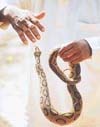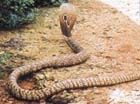Charming
away snake-bites
This vedamahattaya
brings relief to many victims by studying the behaviour and
moods of these creepy crawlies
Snake
bites: do's and don'ts
* Firstly, try not to scare the victim. If the patient becomes
excited, his blood circulation quickens and there is a risk
of the venom spreading faster in the body, thereby worsening
his condition.
* Do not tie up the area of the wound or any area higher than
the wound.
* Do not cut the wound as it will worsen the injury. (sometimes
leads to tetanus as well)
* Squeeze blood out of the wound and wash the wound with running
water by holding the wound under flowing water.
* Do not use a basin of water to wash the wound as the idea
is to get rid of the infected blood. By using a basin of water
one will be washing the wound with water that already contains
infected blood.
* Do not move the patient around too much except for taking
him to a doctor or to the nearest hospital.
By
Chamintha Thilakarathna and Radhika Dandeniya
In the heart of Rajagiriya, Abeyratne vedamahattaya(65) is
busy tending his snakes. He is not a snake charmer, but his
profession requires more skill in handling the creepy-crawlies.
As a researcher and specialist on snake-bite and its cures,
 Abeyratne
vedamahattaya provides relief to many desperate patients with
knowledge from traditional medicine and from his observations
and experiences with snakes. Abeyratne
vedamahattaya provides relief to many desperate patients with
knowledge from traditional medicine and from his observations
and experiences with snakes.
His medicine for each patient is home-made. If the patients
are very ill, he cares for them himself.
A student
of the Thellijjawila Sarpisha specialist, Dr. B.G.Wijeypala
of Galle, Abeyratne vedamahattaya is a registered specialist
doctor on snake-bite. His observations and experiments with
snakes do not include making anti-venom out of snake venom
but he explores the behaviour patterns of snakes to identify
their moods and actions, thereby identifying when a snake
would bite and if its bite is poisonous.
As a student
he collected venom as a means of learning. "We did a
lot of research on snake venom and bites as prescribed in
our ancient traditional medicinal scripts. But, we lacked
adequate equipment to further our experiments," he said.
The snakes
he keeps at his home are shown at exhibitions and keenly observed
by  his
children who are following in his footsteps. They are the
nurses to the patients, assistants to the doctor and caretakers
of the snakes. "My children help me in my work and seem
to have taken a liking to the profession as well," the
proud father said. his
children who are following in his footsteps. They are the
nurses to the patients, assistants to the doctor and caretakers
of the snakes. "My children help me in my work and seem
to have taken a liking to the profession as well," the
proud father said.
He is
regretful that he no longer has as many snakes as before.
"When I was a student in Dr. Wijeypala's house, they
had all the snakes imaginable. But, nowadays, it is difficult
due to lack of space, and also the fact that there aren't
as many snakes around," he said.
He brings
out a cobra and a Russell's Viper and as we jump back in fear,
he smilingly tells us that their venom has not been taken
out. "Don't worry, they won't bite," he assures
us, adding, "Snakes are innocent animals. Often, snakes
bite when they are provoked, by mistake, or in fear."
But the
doctor himself has been a victim of snakebite, not once but
on several occasions. "I have been bitten eight times,
once by a thith polonga (Russell's Viper), twice by a cobra,
three times by a kunakatuwa (Hump-nosed Viper), twice by a
pala polonga (Green pit Viper)," he said. These happened
when he was still a student learning to handle the snakes
and attempting to take out their venom, he explains.
"There
is a way of handling snakes. Once you learn it, avoiding bites
is easy. But most often, once the snakes get used to a person,
they don't bite. Their instincts tell them when the caretaker
is around," he said.
With his
40 years of experience, Abeyratne vedamahattaya says that
sometimes patients who claim to have been bitten by a snake
don't have poison in their system.
This is
because, the snake's fang may have just hit the victim and
even when it has bitten, if the snake is immediately after
a catch, it is not likely that the bite will have poison,
he says.
Diagnosing
how serious the bite is and what type of snake it was, is
made through the state of the wound, the appearance of the
patient and the reactions that follow.
"However,
I do not accept some patients whom I feel are too serious
or incurable. According to the ancient scripts, there are
places in the body said to be 'maru stana' (death spots).
And, if a person is bitten in such a spot, it is deadly. These
include the forehead, neck, eyes, chin, stomach, lips, nipples,
back of shoulder, back and reproductive areas. Also, pregnant
women, children under two, the elderly, those suffering from
urinary problems, weak people and those who take alcohol regularly
must be careful as it will be very difficult to cure them.
The patient's condition thus depends on many factors,"
he explained.
It is
not easy to rear snakes. Each snake has to be fed at a cost
of about Rs.1500 per month and be given enough space to move
about while ensuring they do not escape. For a vedamahattaya
who does not charge his patients, he is quite happy with what
he receives. "Patients may pay me any amount they wish.
It is voluntary."
Abeyratne
vedamahattaya is concerned about the myths that surround snakes
in our country. He says people believe that when a polonga
is around you get the smell of bugs, that when a snake that
has bitten someone is burnt, the patient's condition becomes
worse or that a Mapila sucks blood, etc. "These are myths.
Often the 'goyan messa' is found in many areas where the polonga
also lives. And, they stink anyway but the polonga does not.
There is no link between the two. As for killing snakes, the
patient's condition worsens when he is told of the snake's
death which excites him. Hence his blood circulation increases
spreading the venom faster through the body. The mapila does
not have the capacity to suck blood as its fangs are found
inside unlike in other snakes where they are found at the
edge of their mouths," Abeyratne vedamahattaya said.
But if
one is worried, there are a few preventive steps that could
be taken against snake bite. Wear high rubber boots when walking
in a field, and use a stick, especially at night, for walking.
Reports
of snake bite among the blind are rare. The reason being that
when the canes they carry hit the ground, it sends vibrations
warning the snake that someone is in the vicinity.
Then the
snakes move out of the way. The snake senses through its skin,
and rubber slippers and shoes are soft on the earth and may
not generate enough vibration to warn it away. So, using a
stick when walking would be useful," he explained.
|